SQL
统计数据概况:计算样本总数、商家总数、用户总数、消费总数、领券总数等
select
count(User_id) as '样本总数',
count(distinct Merchant_id) as '商家总数',
count(distinct User_id) as '用户总数',
count(Date) as '消费总数',
count(Date_received) as '领券总数',
(select count(*) from ddm.offline_train as a where a.Date_received is not null and a.Date is not null) as '领券消费总数',
(select count(*) from ddm.offline_train as a where a.Date_received is null and a.Date is not null) as '无券消费总数',
(select count(*) from ddm.offline_train as a where a.Date_received is not null and a.Date is not null)/count(Date_received) as '核销率'
from ddm.offline_train

统计不同距离下:领券人数、用券消费人数、核销率
# 查找各距离的领券人数/用券消费人数/核销率
select
Distance,
count(Coupon_id) as get_coupons_num,
sum(if(Date_received is not null and Date is not null,1,0)) as user_coupons_num,
sum(if(Date_received is not null and Date is not null,1,0)) /count(Coupon_id) as use_coupons_rate
from ddm.offline_train
where Distance is not null
group by Distance
order by distance
 消费券使用情况占比
消费券使用情况占比
# 消费券使用情况占比
with temp as (
select
case
when Date_received is not null and Date is not null then '有券消费'
when Date_received is not null and Date is null then '有券未消费'
when Date_received is null and Date is not null then '无券消费'
end as flag
from ddm.offline_train
)
select
flag as '优惠券使用情况',
concat(round(count(flag)/(select count(*) from temp)*100,2),'%') as '百分比'
from temp
group by flag
order by count(flag)/(select count(*) from temp)

with as 也叫做子查询部分,类似于一个视图或临时表,可以用来存储一部分的sql语句查询结果,必须和其他的查询语句一起使用,且中间不能有分号,目前在oracle、sql server、hive等均支持 with as 用法,但 mysql并不支持!
不同类型优惠券的核销情况和平均领取距离
# 不同优惠券类型的核销情况和平均领取距离
select
Discount_rate as '折扣',
avg(Distance) as '平均距离',
count(Date_received) as '领券人数',
sum(if(Date_received is not null and Date is not null,1,0)) as '有券消费人数',
sum(if(Date_received is not null and Date is not null,1,0))/count(Date_received) as '核销率'
from ddm.offline_train
where Date_received is not null
group by Discount_rate
order by '有券消费人数' desc

不同满减门槛的核销情况
# 不同满减门槛的核销情况
select
mk as '门槛',
count(*) as '领券数量',
sum(if(Date is not null,1,0)) as '用券消费数量',
concat(round(sum(if(Date is not null,1,0))/count(*)*100,2),'%') as '核销率'
from(select
DATE,
convert(if(Discount_rate like '%.%',0,Discount_rate),signed) as mk
from ddm.offline_train) as aa
where mk is not null
group by mk
order by mk

不同核销率的商家分布情况(占比)
# 不同核销率用户分布
with temp as (
select
Merchant_id,
count(Date_received) as get_num,
sum(if(Date is not null and Date_received is not null,1,0)) as use_num,
sum(if(Date is not null and Date_received is not null,1,0))/count(Date_received) as Merchant_rate
from ddm.offline_train
where Date_received is not null
group by Merchant_id
)
select
tag,
concat(round(count(*)/(select count(*) from temp)*100,2),'%') as Merchant_percent
from(
select
Merchant_id,
case
when Merchant_rate = 0 then '核销率:0'
when Merchant_rate > 0 and Merchant_rate < 0.2 then '核销率:0-20%'
when Merchant_rate >= 0.2 and Merchant_rate< 0.3 then '核销率:20%-30%'
when Merchant_rate >= 0.3 and Merchant_rate< 0.5 then '核销率:30%-50%'
when Merchant_rate >= 0.5 then '核销率:50%以上'
end as tag
from temp
)aa
group by tag
order by Merchant_percent desc
 不同领券次数商家的分布情况(平均核销率/占比)
不同领券次数商家的分布情况(平均核销率/占比)
# 不同领券次数用户分布-平均核销率/占比
with temp as (
select
Merchant_id,
count(Date_received) as get_num,
sum(if(Date is not null and Date_received is not null,1,0))/count(Date_received) as user_rate,
sum(if(Date is not null and Date_received is not null,1,0)) as use_num,
case
when count(Date_received)>100 then '100次以上'
when count(Date_received)=0 then '0次'
when count(Date_received) between 1 and 10 then '1-10次'
when count(Date_received) between 11 and 50 then '11-50次'
when count(Date_received) between 51 and 100 then '51-100次'
else '其他次'
end as flag
from ddm.offline_train
group by Merchant_id
)
select
flag as '被领券次数',
concat(round(avg(user_rate)*100,2),'%') as Merchant_avg_use_rate,
concat(round(count(*)/(select count(*) from temp)*100,2),'%') as Merchant_percent
from temp
group by flag
order by (count(*)/(select count(*) from temp)) desc

不同核销率用户分布(占比)
# 不同核销率用户分布
with temp as (
select
User_id,
count(Date_received) as get_num,
sum(if(Date is not null and Date_received is not null,1,0)) as use_num,
sum(if(Date is not null and Date_received is not null,1,0))/count(Date_received) as user_rate
from ddm.offline_train
where Date_received is not null
group by User_id
)
select
tag,
concat(round(count(*)/(select count(*) from temp)*100,2),'%') as user_percent
from(
select
User_id,
case
when user_rate = 0 then '核销率:0'
when user_rate > 0 and user_rate < 0.3 then '核销率:0-30%'
when user_rate >= 0.3 and user_rate< 0.5 then '核销率:30%-50%'
when user_rate >= 0.5 then '核销率:50%以上'
end as tag
from temp
)aa
group by tag
order by user_percent desc
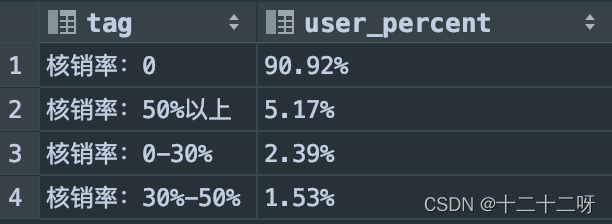
不同月份优惠券领券次数/核销次数/核销率
# 不同月份领券次数/核销次数/核销率
select
`month`,
coupons_get_num,
coupons_use_num,
concat(round(coupons_use_num/coupons_get_num*100,2),'%') as coupons_use_rate
from(select
month(Date_received) as `month`,
count(*) as coupons_get_num
from ddm.offline_train
where Date_received is not null
group by month(Date_received)) as a
inner join(
select
month(Date) as `month`,
count(*) as coupons_use_num
from ddm.offline_train
where Date_received is not null and Date is not null
group by month(Date)
)as b using(`month`)
order by `month`

不同工作日的优惠券平均核销周期、核销率
# 工作日平均核销间隔、核销率
with get_coupons as(
select
weekday(Date_received)+1 as coupons_day,
count(*) as coupons_get_num
from ddm.offline_train
where Date_received is not null
group by weekday(Date_received)+1
),
use_coupons as(
select
weekday(Date)+1 as coupons_day,
count(*) as coupons_use_num,
round(avg(datediff(Date,Date_received)),2) as use_interval
from ddm.offline_train
where Date is not null and Date_received is not null
group by weekday(Date)+1
)
select
coupons_day,
use_interval,
concat(round(coupons_use_num/coupons_get_num*100,2),'%') as coupons_use_rate
from get_coupons
inner join use_coupons using(coupons_day)
order by coupons_day

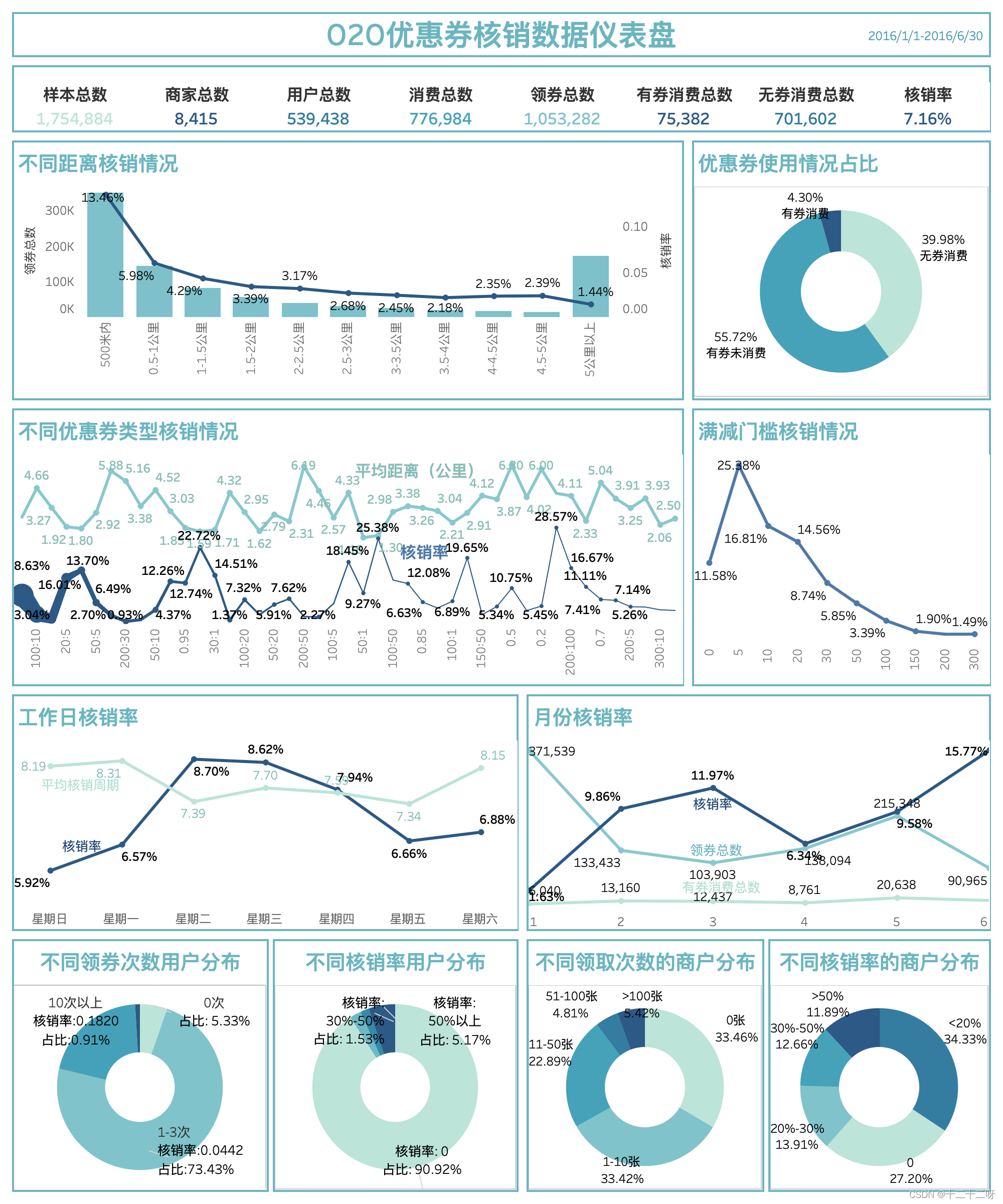
Python
库包
- pandas: 支持从CSV、JSON、SQL、Microsoft Excel load数据,可以对各种维度的数据做归并、再成形、选择,还有数据清洗和数据加工特征
- numpy:存储和操作矩阵、数组计算的包:数组计算、逻辑运算、傅立叶变化和图形操作、跟线性代数相关的操作
- Matplotlib:绘图工具可以绘制线图、散点图、等高线图、条形图、柱状图、3D 图形、甚至是图形动画等。
- sklearn:它涵盖了分类、回归、聚类、降维、模型选择、数据预处理六大模块,降低机器学习实践门槛,将复杂的数学计算集成为简单的函数,并提供了众多公开数据集和学习案例。
import pandas as pd
import numpy as np
import matplotlib.pyplot as plt
from pylab import *
import seaborn as sns
from sklearn import model_selection, preprocessing, naive_bayes, metrics, svm
from sklearn.model_selection import train_test_split, GridSearchCV
from sklearn.linear_model import LogisticRegression
from sklearn.neighbors import KNeighborsClassifier
from sklearn import ensemble, tree
# 忽略警告提示
import warnings
warnings.filterwarnings('ignore')
1.导入和了解数据特征
data = pd.read_csv(r"/Users/xll/Documents/服务数据质量/测试数据1.csv")
#返回数据集行和列的元组,其中data.shape[0]代表返回行数,data.shape[1] 代表返回列数
print(data.shape)
#返回数据集的所有列名
data.columns
#随机返回样本5行
data.sample(5)
#返回前5行
print(data.head(5))
#返回浮点型和正行字段的均值、最大值、等统计数据
print(data.describe())
#numpy包的这个方法也是可以得到同样的结果
import numpy as np
print(data.describe(include=[np.number]))



2.数据预处理:以泰坦尼克号沉船数据分析
2.1 读取数据,并随机获取5行观察数据特征
data = pd.read_csv('titanic.csv')
print(data.shape) #输出:(891, 15)
data.sample(5)

2.2 查看各字段的缺失值
data.isnull().sum()
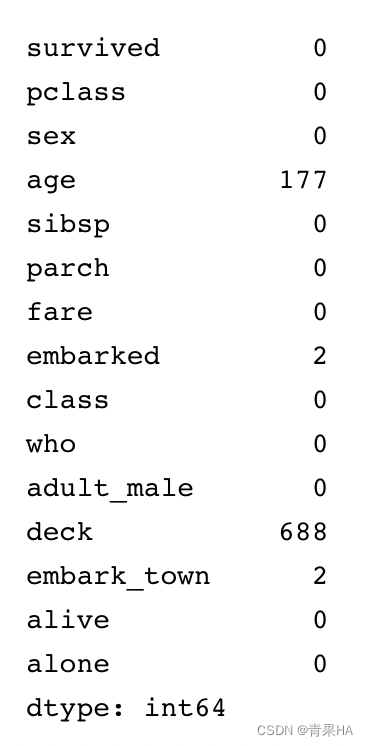
2.3 缺失值分析和缺失值处理
age、deck、embarked、embark_town 存在缺失值,需要处理。
(1)age 对生存率有影响,不能忽略,用平均值填充;
(2)总共有 891 条信息,deck 有 688 个缺失值,因此剔除 deck 这个分类标签;
(3)embarked、embark_town 缺失值较少,都为 2 个,随机取其中一个数据填充。
//用平均年龄补充年龄缺失的字段
data['age']=data['age'].fillna(data['age'].median())
//因该特征缺失占比是99%,所以删除deck特征
del data['deck']
//只有两条记录缺失,随机补充
data['embarked']=data['embarked'].fillna('S')
data['embark_town']=data['embark_town'].fillna('Southampton')
//再次查询下空值的记录总和,返回都是0
data.isnull().sum()
3.数据特征分析
3.1.1全体成员生存和死亡情况汇总
//定义一个survive的矩阵:死亡为0,生存为1;统计死亡人数、生存人数和死亡及生存率
survived = data['survived'].value_counts().to_frame().reset_index().rename(columns={'index': 'label', 'survived': 'counts'})
#计算存活率
survived_rate = round(342/891, 2)
survived['rate'] = [1-survived_rate, survived_rate]
print(survived)
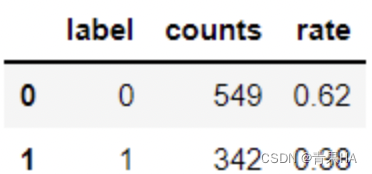
3.1.2绘制扇形图
mpl.rcParams['axes.unicode_minus'] = False #处理无法显示中文的问题
mpl.rcParams['font.sans-serif'] = ['SimHei']
fig=plt.figure(1,figsize=(6,6))
ax1=fig.add_subplot(1,1,1)
label=['遇难','存活']
color=['#C23531','#F5DEB3']
explode=0.05,0.05 #扇区间隔
patches,l_text,p_text = ax1.pie(survived.rate,labels=label,colors=color,startangle=90,autopct='%1.0f%%',explode=explode,shadow=True)
for t in l_text:
t.set_size(20)
for t in p_text:
t.set_size(20)
ax1.set_title('全体成员的生存情况', fontsize=20)

3.2.1其他特征数据分析
fig = plt.figure(figsize=(15,10))
fig.set(alpha=0.3) # 设定图表颜色alpha参数(透明度)
plt.subplot2grid((2,3),(0,0))
data.survived.value_counts().plot(kind='bar')
plt.title("获救情况 (1为获救)")
plt.ylabel("人数")
plt.subplot2grid((2,3),(0,1))
data.pclass.value_counts().plot(kind="bar")
plt.ylabel("人数")
plt.title("乘客等级分布")
plt.subplot2grid((2,3),(0,2))
plt.scatter(data.survived, data.age)
plt.ylabel("年龄")
plt.grid(b=True, which='major', axis='y')
plt.title("按年龄看获救分布 (1为获救)")
plt.subplot2grid((2,3),(1,0), colspan=2)
data.age[data.pclass == 1].plot(kind='kde')
data.age[data.pclass == 2].plot(kind='kde')
data.age[data.pclass == 3].plot(kind='kde')
plt.xlabel("年龄")
plt.ylabel("密度")
plt.title("各等级的乘客年龄分布")
plt.legend(('头等舱', '2等舱','3等舱'),loc='best')
plt.subplot2grid((2,3),(1,2))
data.embarked.value_counts().plot(kind='bar')
plt.title("各登船口岸上船人数")
plt.ylabel("人数")
plt.show()
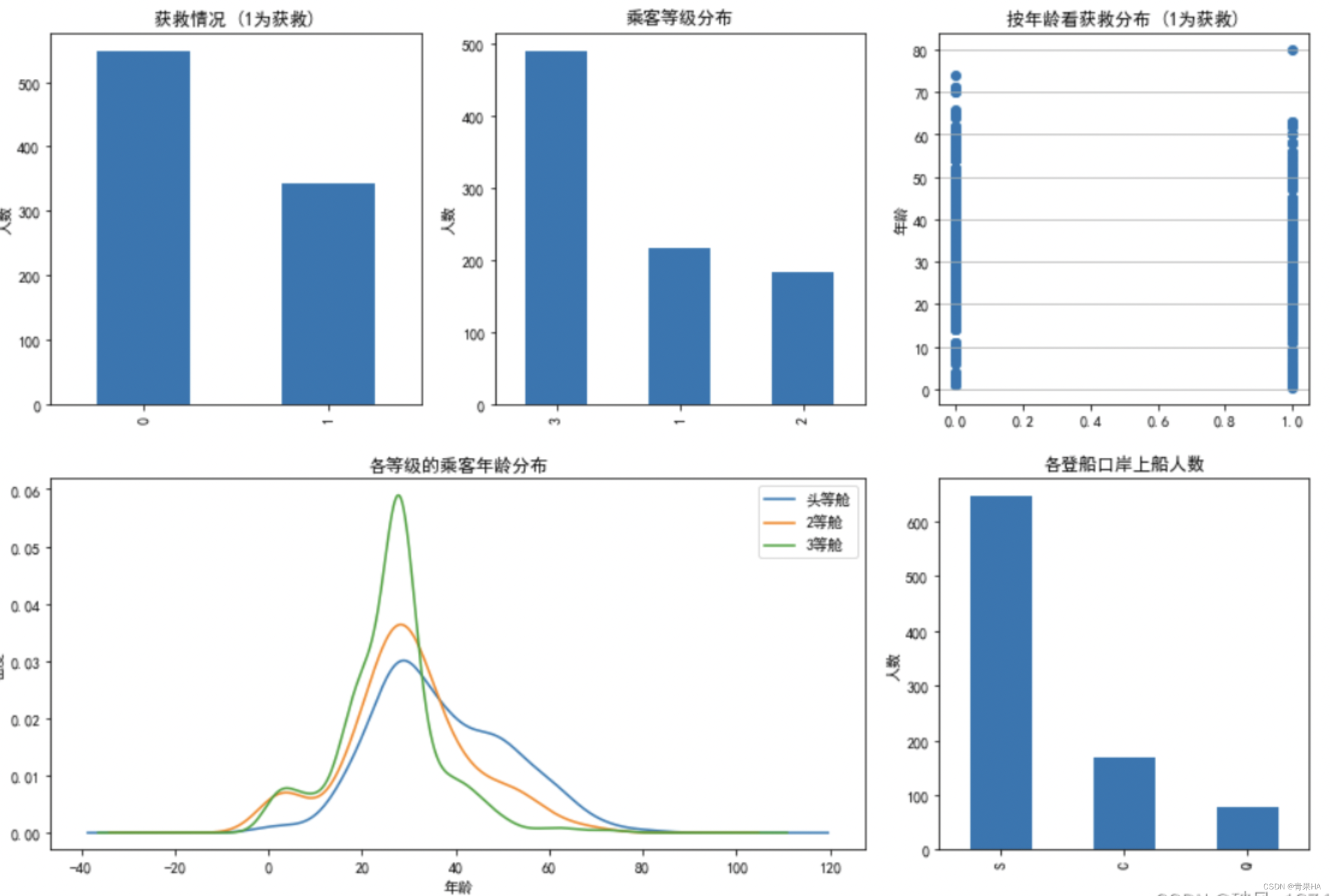 3.3特征关联分析
3.3特征关联分析
sns.heatmap(data.corr(),annot=True,cmap='RdYlGn',linewidths=0.2)
fig=plt.gcf()
fig.set_size_inches(10,8)
plt.show()

参考:
https://blog.csdn.net/twlve/article/details/128609147?spm=1001.2014.3001.5502
https://blog.csdn.net/twlve/article/details/128626526?spm=1001.2014.3001.5502
O2O优惠券核销-数据分析_十二十二呀的博客-CSDN博客_优惠券数据分析
版权归原作者 青果HA 所有, 如有侵权,请联系我们删除。